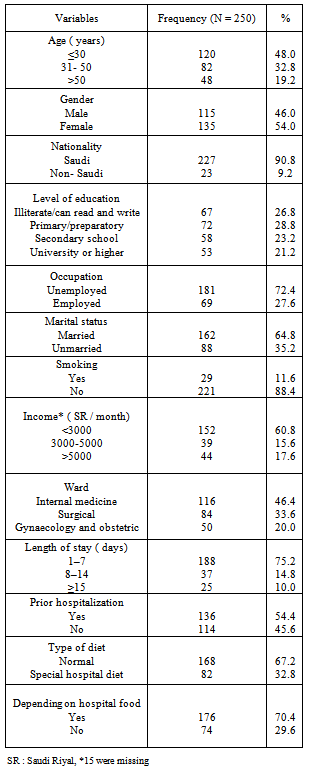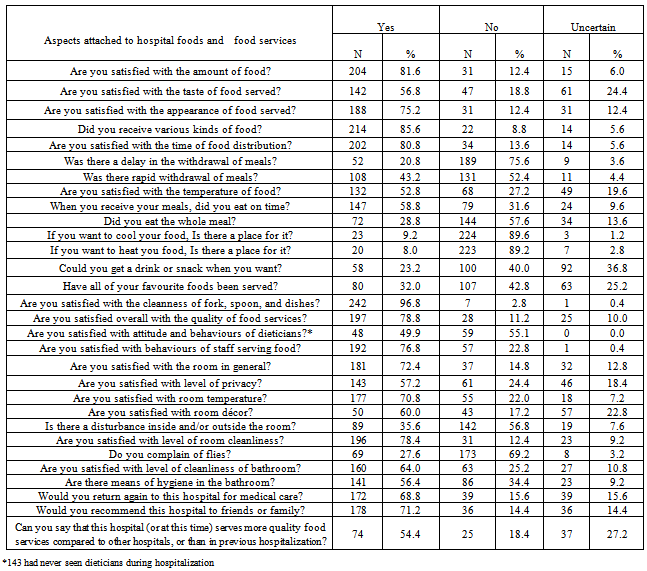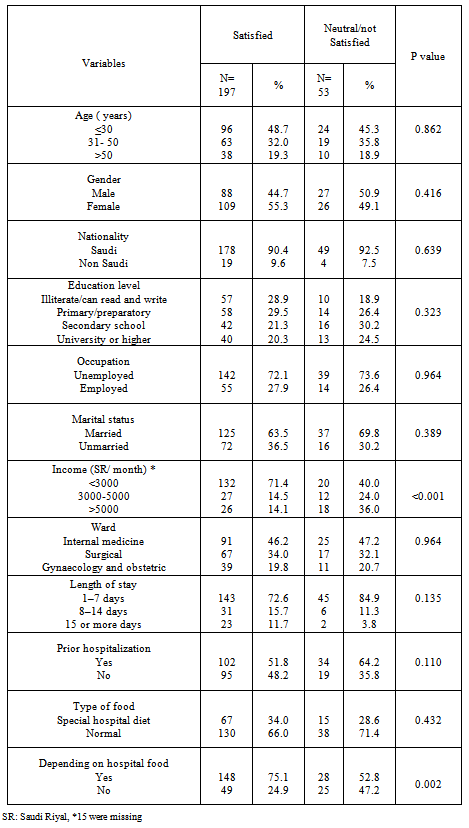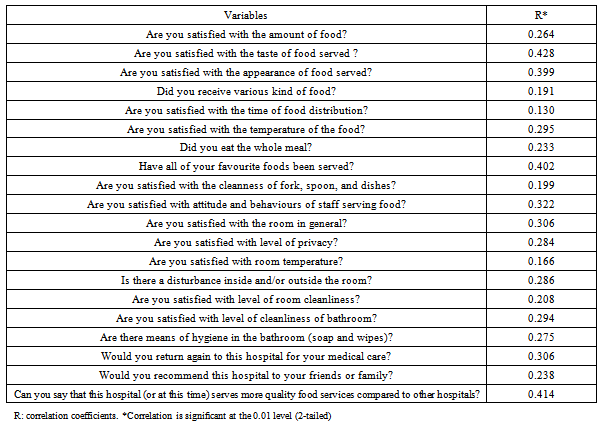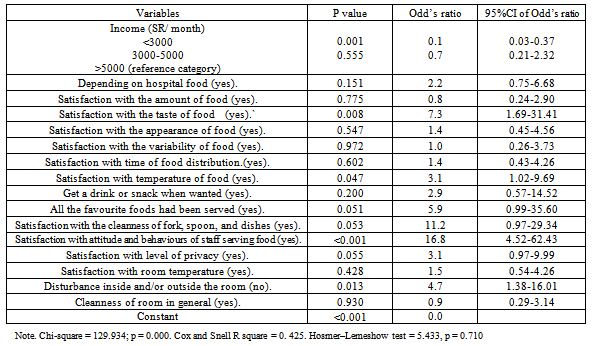-
Paper Information
- Next Paper
- Previous Paper
- Paper Submission
-
Journal Information
- About This Journal
- Editorial Board
- Current Issue
- Archive
- Author Guidelines
- Contact Us
American Journal of Medicine and Medical Sciences
p-ISSN: 2165-901X e-ISSN: 2165-9036
2012; 2(6): 123-130
doi: 10.5923/j.ajmms.20120206.03
Analysis of Factors Affecting the Satisfaction Levels of Patients Toward Food Services at General Hospitals in Makkah, Saudi Arabia
Amany M. Abdelhafez 1, 2, Lina Al Qurashi 2, Reem Al Ziyadi 2, Aroob Kuwair 2, Maram Shobki 2, Haneen Mograbi 2
1Department of Public Health, Faculty of Medicine, Ain Shams University, Cairo, Egypt
2Department of Clinical Nutrition, Faculty of Applied Medical Sciences, Umm Al-Qura University, Saudi Arabia
Correspondence to: Amany M. Abdelhafez , Department of Public Health, Faculty of Medicine, Ain Shams University, Cairo, Egypt.
| Email: |  |
Copyright © 2012 Scientific & Academic Publishing. All Rights Reserved.
Previous studies showed that hospital food services remain to be a widespread problem all over the world. This study was conducted to determine the factors affecting satisfaction level of patients with food services in a sample of general hospitals in Makkah, Saudi Arabia. A cross sectional study was carried out in four general hospitals including 250 patients. Interview questionnaire was used for measuring satisfaction of the patients with food and food services. Results showed that (78.8%) of patients were satisfied overall with quality of food services in hospitals. Positive correlation was detected between the overall satisfaction level and the different aspects related to food and food services, the first three variables that had the strongest correlation with overall satisfaction were the taste of foods, being served with the favourite food and food appearance. Logistic regression analysis revealed that low monthly income, taste and temperature of food, attitude of staff serving food, and absence of disturbance inside, and outside the room were associated with satisfaction with hospital food and food services (p < 0.05) .Increasing the quality of foods and hospital food services increases the level of overall satisfaction with foods and food services. Ongoing education and communication with patients and dieticians is important in improving satisfaction with foodservice.
Keywords: Hospital Food Services, Patient Satisfaction, Food Preferences, Healthcare Quality
Cite this paper: Amany M. Abdelhafez , Lina Al Qurashi , Reem Al Ziyadi , Aroob Kuwair , Maram Shobki , Haneen Mograbi , "Analysis of Factors Affecting the Satisfaction Levels of Patients Toward Food Services at General Hospitals in Makkah, Saudi Arabia", American Journal of Medicine and Medical Sciences, Vol. 2 No. 6, 2012, pp. 123-130. doi: 10.5923/j.ajmms.20120206.03.
Article Outline
1. Introduction
- Patient satisfaction has become a key criterion by which the quality of health care services is evaluated. When looking at overall hospital patient satisfaction, foodservice satisfaction may sometimes go unnoticed, as nursing and physician quality and the quality of technical medical care are more commonly identified in the research[1-3]. Several researchers have identified food quality as the most important determinant of patient foodservice satisfaction[1, 4, 5].A comprehensive literature review reveals that there are so many studies conducted on satisfaction in health care facilities as well as in other service providers, but the number of studies on the satisfaction with food services in health care facilities is relatively low[6,7]. However, food service in a hospital is an important component of treatment process since it affects the length of recovery and life quality[6].Studies on satisfaction with food services discuss that the quality of hospital food services is a common problem in all over the world, and patients of many hospitals are undernourished, since the patients do not like the food or they say the food is unacceptable[8,9]. Hospital malnutrition is a main problem, since it increases the severity of illnesses, and lengthens recovery duration, and length of stay[6, 10-12]. However, the need to assess the food services in a hospital is not only important for patients’ welfare and nutrition but also for financial reasons[6].As far as the hospitals are concerned, food services that satisfy the needs of patients will primarily decrease food wastage, and will contribute in making significant savings[6 ,13], For this reason, hospital food services should be seen as an inseparable part of patient treatment process[6,14], and it is important to evaluate patient views to make sure on whether the food served to the patients meets the expectations of customers[7]. The present study was conducted to determine the factors affecting satisfaction level of patients with food services in a sample of general hospitals in Makkah, Saudi Arabia.
2. Material and Methods
2.1. Subjects
- A cross sectional study was conducted between January and June 2011.The study was carried out in Heraa, Al Nour, king Abdulaziz and King Faisal hospitals in Makkah, Saudi Arabia. Permissions for the study were obtained from the authorities concerned .The main criteria for the sample selection were the ability of the patients on evaluating food service quality. After meeting sample selection criteria, the patients were informed about the study, and patients who accepted to participate in the study voluntarily were included in the sample. For this reason, those patients who were unable to complete the questionnaire and patients in paediatrics and psychiatric services were not included in the sample of this study. At the last a convenient sample of 250 selected patients was included in this study.
2.2. Methods
- Data were collected using an interview questionnaire. Unfortunately, a valid, reliable, and sound questionnaire was not found. The questionnaire was adapted from[1,6].The clarity of the statements was examined by conducting a pilot study on a small group of patients before starting the study.The questionnaire was divided into 4 parts: Part (1) included the admission data, part (2) to collect data about socio-demographic characteristics, part (3) to determine the level of satisfaction of patients with the different aspects of food and food services, and part (4) to determine the patient perception on the quality of hospital in general. The patients were required to give their opinions whether or not they were satisfied with the different items included in the questionnaire by giving three choices (yes, no, or uncertain). These responses were assigned the following scores: Yes = 3, uncertain = 2, and No = 1. There were also questions using three-point scoring schemes with responses similar to those, but where the awarding of points was reversed. For example, the question “Was there a delay in the provision of meals?” would be scored: Yes = 1, uncertain = 2, and No = 3. For comparison purposes, dissatisfied and uncertain patients were pooled in the same category, and this category of patients was compared with satisfied patients.
2.3. Statistical Analysis
- Data were analyzed by using Statistical Package for Social Science (SPSS) version 16.0 (SPSS Inc., Chicago, IL, USA).Descriptive statistics were used to summarize the socio-demographic characteristics of the patients, satisfaction levels, and quality of food services. For quantitative variables, compliance with the normal distribution was assessed using the Kolmogorov-Smirnoff test, as appropriate. The chi-square test or Fisher’s exact test were used for qualitative variables. T-test or Mann Whitney test were used for quantitative data. The relationship between overall satisfaction and the various aspects related to food and food services was examined by using Spearman correlation. Logistic regression analysis was used to detect the variables that best predict patient satisfaction. P value of less than (0.05) was considered to indicate statistical significance.
3. Results
|
|
|
|
|
|
4. Discussion
- Patient satisfaction is an important element in evaluating the quality of health care services, and in predicting patients’ behavioural patterns after receiving the services. In addition, studies on patient satisfaction can identify facility attributes or practices that increase satisfaction and utilization, which may lead to favourable outcomes[1, 15, 16].Regarding the socio-demographic characteristics of the studied patients, the result of this study showed that patient specific characteristics such as age and gender to be insignificant variables in affecting overall satisfaction of the patients. However, in almost all the studies, age did not have an effect on the level of patient satisfaction[1]. This is in contrast to Sahin et al., 2006 who found that satisfaction level was significantly higher in younger age groups[6]. In addition, other previous studies reported that patients aged 70 and older gave higher overall foodservice ratings when compared to younger patients[4]. On the other hand a patient satisfaction study to assess hospital services in Kuwait concluded age as the most important determinant for overall satisfaction[17], and another study in Sri Lanka stated that the satisfaction level was significantly low for the age group 21- 50 years[18], while a study in China has concluded that increasing age had been a negative predictor of patient satisfaction[17].Considering the education level, the present study revealed that no association between the level of education and the overall satisfaction of the studied patients, similar results were reported by Sahin and his colleagues in 2006[6], while Al-Hoqail and his colleagues in 2010 reported that less educated patients were generally more satisfied since they were less demanding[16]. Patients who had tertiary education were shown to have significantly lower levels of satisfaction in a study conducted in United Arab Emirates[19] and Saudi Arabia[20]. Other studies uniformly showed no such relationship[17].In addition to this, low monthly income of patients was significantly associated with higher level of satisfaction, this may make patients satisfied with any services that they were provided, similar result were reported by Watters and his colleagues (2003), however Sahin and his colleagues (2006) found that patients with high income were more satisfied than others with low income[5,6] .The study also showed that food type (special hospital diet or normal) was not a significant determinant of overall satisfaction with hospital food and food services, and this finding supports the findings of the study of Sahin, and his colleagues in 2006[6]. The results of both this and Sahin, and his colleagues suggest that a special diet given for treatment purpose could be as attractive as normal diet.The importance of temperature in patient foodservice satisfaction is mentioned in the literature[1, 3], in the current study temperature of food was one of important determinants of overall dissatisfaction, the results of logistic regression suggest that increasing the level of satisfaction with temperature of foods decreases the level of dissatisfaction or increases overall satisfaction among the patients. Unlike the studies conducted by Sahin, and his colleagues[6], and Tranter, and his colleagues[1]who did not found such association. As far as the hospitals are concerned, food services that satisfy the needs of patients will primarily decrease food wastage, and will contribute in making significant savings[10].The current study showed that (29.6%) of patients were not depending on hospital diet. This problem was touched on by other studies. For example, the study conducted by Sahin and his colleagues ( 2006) showed that the majority of patients reportedly consumed less than 50% of their food, 28.9% consumed only the half of their food, 23.5% consumed some of their meals, and 3.2% of patients did never eat their foods[6], while the study conducted by Kowanko, and his colleagues (2001), reported that one third of the patients consumed only 50% of hospital food and as a result, nutritional requirements of a significant amount of patients were not met and malnutrition problems occurred[21]. In another study on an elderly population by Hamilton and colleagues (2002), found that 59% of the patients consumed all of their food, 21% consumed one third of the food provided, 12% ate half and 9% of the patients consumed two thirds of the food provided[22]. Similarly, in the study by Barton and colleagues (2000), 40% of the food delivered was not consumed and hospital resources were wasted by the remainder food disposed[13]. Hospital malnutrition is a main problem, For this reason, hospital food services should be seen as an inseparable part of patient treatment process, and it is important to evaluate patient views to make sure on whether the food served to the patients meets the expectations of customers[10-12, 14].The results of this study showed that there was a positive correlation between length of stay and overall satisfaction with hospital food and food services, and this finding supports the study findings of Tranter and his colleagues who found that patients who had a longer hospital stay giving higher food-quality ratings when compared with patients with shorter hospital stays[1], in contrast to Sahin and his colleagues[6] and Stanga and his colleagues[3] who found a negative relationship between length of stay and overall satisfaction with hospital food and food services.Several researchers have found that staff interacting with patients during meal service can influence their foodservice satisfaction. A study compared meal service quality when nurses or dietary staff delivered trays, found that patients served by dietary staff were more positive about food quality and appearance than when served by nurses. Personal contact with staff is beneficial because patients perceive emotional support[5]. In this study higher percentage of patients (78.8%) were satisfied with the attitude, and behaviour of the staff serving foods which was positively correlated with the overall satisfaction rate, similar results were reported by other studies[1,6]. Room service is a valuable asset for hospitals in improving patient satisfaction, clinical outcomes for patients, the health of patients restored and their recovery quickened. At the very least, room service gives patients control over one aspect of their hospitalization which improves the quality of their stay and their opinion of the overall quality of care received. Room service systems improve patient nutrient intake and assists in their recovery and regaining of their health[24] .The current study showed positive correlation between room service quality and ,the overall satisfaction with food ,and food services , also higher percentage of patients were satisfied with the different aspects related to room service ,where 72.4%,70.8%.78.4% were satisfied with the room in general , room temperature ,and cleanliness respectively ,similar results were observed by Alaloola and Albedaiwi (2007)[16].However, there are some limitations of this study, the study is restricted to 4 general hospitals, and no private hospitals were included, so the results may not be generalizable to other hospitals. It should also be mentioned here that high percentage of the study population were less than or equal 30 years old. Given the predominance of younger patients in this study, results may not be generalizable to other hospitals’ population. Another weakness of the study is related to measuring food consumption levels, which was not measured in this study.
5. Conclusions
- The majority of patients were satisfied overall with food and food services. Increasing the quality of foods and hospital food services increases the level of overall satisfaction with foods and food services. Ongoing education and communication with patients and dieticians is important in improving satisfaction with foodservice.
ACKNOWLEDGEMENTS
- The authors thank all patients who participated in the study for their cooperation. Also appreciate the role played by the department of clinical nutrition in both the general hospitals in Makkah Governorate and Faculty of applied medical sciences at Umm Al-Qura University for their kind help .
 Abstract
Abstract Reference
Reference Full-Text PDF
Full-Text PDF Full-Text HTML
Full-Text HTML